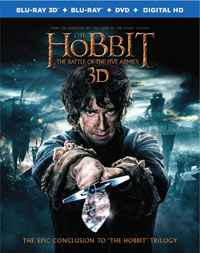
The Hobbit: The Battle of the Five Armies

 – for extended sequences of intense fantasy action violence, and frightening images.
– for extended sequences of intense fantasy action violence, and frightening images.
Director: Peter Jackson
Starring: Martin Freeman, Ian McKellen, Richard Armitage, Evangeline Lilly, Orlando Bloom, Luke Evans, Billy Connolly
Running Time: 2 hours, 24 minutes
Theatrical Release Date: December 17, 2014
Official Site
Blu-Ray Release Date: March 24, 2015 (Amazon.com)
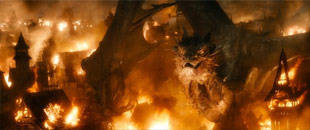
Plot Summary
“The Hobbit: The Battle of the Five Armies” brings to an epic conclusion the adventures of Bilbo Baggins, Thorin Oakenshield and the Company of Dwarves. Having reclaimed their homeland from the Dragon Smaug, the Company has unwittingly unleashed a deadly force into the world. Enraged, Smaug rains his fiery wrath down upon the defenseless men, women and children of Lake-town.
Obsessed above all else with his reclaimed treasure, Thorin sacrifices friendship and honor to hoard it as Bilbo’s frantic attempts to make him see reason drive the Hobbit towards a desperate and dangerous choice. But there are even greater dangers ahead. Unseen by any but the Wizard Gandalf, the great enemy Sauron has sent forth legions of Orcs in a stealth attack upon the Lonely Mountain.
As darkness converges on their escalating conflict, the races of Dwarves, Elves and Men must decide – unite or be destroyed. Bilbo finds himself fighting for his life and the lives of his friends in the epic Battle of the Five Armies, as the future of Middle-earth hangs in the balance.
(from Movieweb.com)
Film Review
It’s hard to believe that it’s been about thirteen years since viewers began the visual journey to J.R.R. Tolkien’s Middle-Earth in a way never seen before. Peter Jackson’s The Lord of the Rings changed cinema forever and created a series of fantasy adventure films that will be cherished and honored for decades to come. Two years ago, in 2012, Jackson took us back to Middle-Earth for the prequel story, The Hobbit. The once-planned two-part movie stretched to a trilogy, approached similarly (but not quite as effectively) as the Rings series, and now, in 2014, The Hobbit comes to a close with the third film, The Battle of the Five Armies.
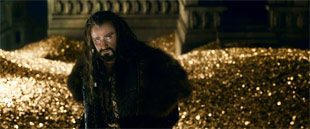
It’s a bittersweet event for sure. While it’s high time we wrap up the drawn-out Hobbit tale, it’s sad to wave a final fond farewell to the cinematic Middle-Earth experience. The second film, The Desolation of Smaug ended abruptly, leaving quite the cliffhanger as the massive dragon Smaug flew off to incinerate the small village of Lake-town. Viewers had to wait a year to see the resolution, and The Battle of the Five Armies (at one time titled There and Back Again) wraps things up rather nicely while continuing to lay the groundwork for the following Lord of the Rings trilogy. And it’s the latter point that was often criticized of the Hobbit films. However, after revisiting these Hobbit movies at home, I came to realize how it seems only fair for Jackson to be able to unite his two cinematic trilogies, even if it’s a bit too forced at times, like with George Lucas’ treatment of the Star Wars prequels in relation to his original films. Still, Jackson fairs far better here than Lucas did, even if some similar problems exist. The biggest of which might be the apparent shoehorning of Rings characters into The Hobbit where they don’t otherwise belong. Not only does Legolas look considerably older in these prequels, but he wasn’t even in The Hobbit book, and when this film finds his father telling him to seek out Strider, it feels just too contrived and out of place. The problem with prequels trying to ride the excitement of seeing old characters again rather than them just fitting into the story seamlessly seems to do more harm than good in the end. The tone of Rings was so much more laid back as if it was often playing out as it should be, whereas, seeing Elrond appear in a battle scene to save the day feels much more like a crowd-pleasing moment to say “Hey, look everyone! It’s Hugo Weaving’s elf from Lord of the Rings! He’s back!” in an effort to excite and surprise the audience. It doesn’t feel natural and it makes these movies feel just a little cheapened for it.
Still, it’s not the worst thing that could happen to these prequels. After seeing this conclusion, I’m excited to rewatch the Lord of the Rings films as soon as possible and eventually watch all 6 in succession someday (not all in the same day of course). Jackson aimed for continuity and, for the most part, has done a great job with it. For The Hobbit-exclusive characters, like the dwarves, and Martin Freeman’s “young Bilbo,” there’s a parallel between how the third Lord of the Rings, The Return of the King, plays out, and how The Battle of the Five Armies unfolds. Heroes become quasi-villains and let us down, and evil threatens to rule the land, but good always endures. Stubbornness proves to be just as strong a foe as the evil forces themselves, and lives are ultimately lost. We’re forced to watch characters we’ve come to love get killed and see a grand tale come to a close. In the end, really, these stories aren’t too dissimilar. Still, it’s fun and bittersweet to see Bilbo toy with the One Ring, and for this story to end just where The Fellowship of the Ring begins… continuing the overall story of brave little, unassuming hobbits doing extraordinary things.
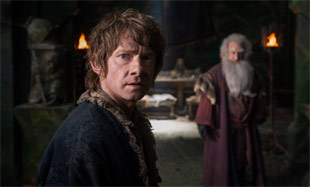
The best way to view The Battle of the Five Armies is immediately, or shortly after, watching (or rewatching) The Desolation of Smaug. While all the movies are meant to be viewed as chapters, Desolation and Battles play out as if it’s all one movie. Never before has any of the Rings or Hobbit films ended so abruptly and picked up immediately after the previous film. (Jackson always has a flashback or side story introduce the next chapter.) When Smaug flies off from the castle to attack Lake-town at the end of Desolation, Five Armies opens with the town scurrying to escape the dragon’s wrath. There’s no recap, there’s no “Previously… on The Hobbit,” there’s no explanation or exposition about the events that transpired earlier–you need to know what happened before so you can appreciate what happens next. I can’t stress enough how much you should really watch the first two again (or for the first time) before viewing this entry. As a continuation of the story, it’s very good, although it isn’t long before we begin to see the effects of the treasure on Thorin and the Company, and see other armies assembling to try to claim the wealth of the mountain from the dwarves. It’s a catalyst for a lot of drama (some new, some familiar), while we see the progression of other storylines (like the love triangle between Tauriel, Kili and Legolas, or the power struggle in Lake-town). For the most part, the movie works as a whole, and it’s a good finale, but there’s plenty of little things that make you wonder what in the world Jackson was thinking?
One really has to wonder what was on Jackson’s mind when he decided to give the unibrow-wearing little weasle Alfrid a more prominent role this time around. He continues to pop up here and there and is pretty much the “new” Wormtongue, and he never gets easier to endure as the movie progresses. I guess he’s supposed to be comic relief, but he’s a blight on the film and nothing more. Then there are other cringe-worthy moments, like Legolas running up rocks as they fall in mid-air, or the sappy delivery of a really bad line by Tauriel later in the film. While these movies aren’t without an eye-rolling moment or two, the fact that it’s a problem that just continues to surface in these movies makes it a little harder to take Jackson’s work seriously–especially when it goes from a silly moment to one we’re meant to take entirely seriously. Furthermore, some of the CGI is weak at best. Some trolls show up that just look purely awful, as well as a dwarf version of Billy Connolly’s character Dain looking very poorly of all CG, and it leads one to wonder if Jackson and Company ran out of funds or time to really polish off the effects. Even some clearly green-screened moments inside the dwarf castle are surprisingly horrendous and distracting, and in a time when special effects can look really amazing, it’s especially surprising.
Otherwise, Howard Shore turns in another phenomenal score that helps to unite the six films. And little thematic callbacks to Lord of the Rings cues is always a nice touch. Jackson’s style for the look and feel of the movie helps greatly in unifying the visuals and all of the films, and by this third film (and after having rewatched the first two Hobbit installments a couple of times), these characters really feel like warm friends. Sure, big army battles in Middle-Earth are old hat for these kinds of movies by now, but Jackson still knows how to keep these films fun and entertaining. And Martin Freeman continues to be a wonderful Bilbo Baggins and a true highlight of this series. Ian McKellen seems more on his game with Gandalf for this entry, and Richard Armitage shows off his acting chops by bringing a pretty rounded performance to Thorin. Orlando Bloom continues to give audiences a more hardened version of Legolas than we’re used to (but I suppose it was the Fellowship that had softened him in the end, eh?), while Evangeline Lilly’s elf Tauriel is arguably a nice addition to Jackson’s Middle-Earth cast of characters. In the end, it’s just another good entry into Middle-Earth storytelling, even if it pales in comparison to the original Rings trilogy.
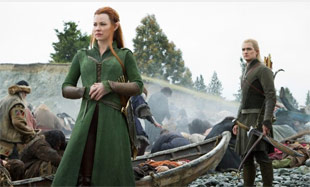
The content for the film is mostly one of violence and scary imagery involving the orcs and such, including the leaders Bolg and Azog. They’re tough to look at at times, so younger viewers may certainly have a tough time with them. Once the battle amps up toward the second half of the film, the violence increases significantly as well. Especially near the finale, we see quite a few orcs get beheaded during the battle, while a few heroes are impaled with blades. Most of the main characters have varying amounts of blood and scrapes on their faces throughout the finale, too. And a major showdown between two characters involves blades running them through and blood flowing in a frozen lake. It’s dramaic stuff and not for the faint of heart. There’s actually just a tiny bit of pretty mild language this time around, with Dain using “b*stard” and the slang phrase “sod off,” which is more of a British term, but it’s a strong one. Otherwise, expect mostly violence when it comes to the content of this one.
Overall, The Hobbit: The Battle of the Five Armies is a fine conclusion to The Hobbit series, even if it’s surely not a perfect one. If you liked the first two, you’ll probably like this one, but if there were too many things about the others that irked you, you’re better of just passing Five Armies by. It’s tough to say goodbye to Bilbo, Gandalf, Thorin & his Company and Middle-Earth, but it was a pretty fun cinematic experience–and one I’m ready to revisit again and again in the future.
– John DiBiase, (reviewed: 12/19/14)
Blu-Ray Special Features Review
The third and final Hobbit film, The Battle of the Five Armies, arrives on disc to own two weeks after hitting the digital retailers. But Warner has released it in a loaded 5-disc 3D Blu-Ray set that contains the movie on 2 3D Blu-Ray discs, a 2D Blu-Ray disc for the film and another just for bonus features, a DVD of the film, and a code to redeem an Ultraviolet copy. You can also get the 3-disc 2D Blu-Ray/DVD/Ultraviolet set and a 2-disc DVD set.
The Hobbit: The Battle of the Five Armies 3D – This 3D Blu-Ray release was my second time seeing a film of this series in 3D. The Battle of the Five Armies was shot in 3D and so it often really pops out at the viewer while watching it. Maybe I’m just getting used to watching 3D movies more often, but this one seemed to be a step above some other 3D releases, but still, overall, it isn’t really a movie that screams to be seen in 3D, but for the most part, it translates well in this format. Seeing the movie again, I enjoyed it the second time (first time in 3D; I saw it in 2D in the theater), but some of the silliness of some of the plot stood out a bit more. And I hated Alfrid so much more this time around. Still, it’s bittersweet to say goodbye to Freeman’s take on Bilbo, the dwarves, and Middle-Earth.
2D Blu-Ray, Disc One:
New Zealand: Home of Middle Earth, Pt 3 (6:07) – The previous two Blu-Ray releases each included a video segment very similar to this one. It’s a cast and crew reflection on shooting on location in New Zealand for The Hobbit films. They also show us more scenic shots from the country and then the final shot used in the film to show you just how naturally majestic the real landscapes are. It’s obvious, now a third time seeing a featurette like this, how there must have been some kind of agreement to help promote tourism in the country in exchange for shooting there again. One interesting tidbit you do learn in this third and final installment, is that they had built the city of Dale on a mountainside in New Zealand!
2D Blu-Ray, Disc Two:
Surprisingly enough, the extras are a little thin on this third entry. While it’s obvious that they’re saving up the core of it all for the last Extended Edition release later this year, it still seemed like there should be a bit more offered here than about an hour’s worth of extras.
Recruiting The Five Armies (11:39) – The first featurette is a little nod to the extras and film crew who helped populate the “five armies” in the film. We hear from several extras reflecting on their experience on set, the different kinds of extras there are, and even how some of them had multiple roles. All in all, it serves as a little love letter to the extras.
Completing Middle-Earth – The featurettes for the rest of the disc focus more on wrapping up the series of all six movies than making the last film.
A Six Part Saga (9:54) examines all six films–The Hobbit trilogy and The Lord of the Rings trilogy–and features the cast and crew talking about the story, themes that run throughout them, and how all six films tie into each other.
A Seventeen-Year Journey (8:59) – This is an emotional look at making all six movies in 17 years’ time. It definitely will warm the hearts of diehard fans and anyone who’s been following this film series since The Fellowship of the Ring!
The Last Goodbye
Behind The Scenes Featurette (11:18) – The retrospective continues as they focus the rest of the featurettes on the song and music video “The Last Goodbye” that rolls during the film’s credits. This behind-the-scenes segment tells of how they came to the idea of using actor Billy Boyd–who played Pippin in The Lord of the Rings series–to sing the end credits song after fans really took to the use of Pippin’s song from Return of the King in the Five Armies trailer. This featurette covers the song’s recording process, how Billy did 430 recording takes(!!), how the song wraps up the saga, and how the use of Billy’s song is meant to pass the torch from Hobbit to Rings.
Music Video (4:21) – The music video features Billy Boyd singing into a studio mic with clips from all six films, and behind-the-scenes moments, cut in. It’s a really great homage to the series.
Trailer 2 / The Hobbit: The Desolation of Smaug Extended Trailer – The featurettes conclude with a trailer for Battle of the Five Armies and for the Extended Edition of The Hobbit: The Desolation of Smaug.
– John DiBiase, (reviewed: 3/22/15)
Parental Guide: Content Summary
![]() Sex/Nudity: Alfrid disguises himself as a woman to hide from the orcs and to take safety. When Bard calls him out on it, he protests while stuffing the chest of the dress with treasure. When he leaves, Bard tells him his slip is showing.
Sex/Nudity: Alfrid disguises himself as a woman to hide from the orcs and to take safety. When Bard calls him out on it, he protests while stuffing the chest of the dress with treasure. When he leaves, Bard tells him his slip is showing.
![]() Vulgarity/Language: 1 “b*stard,” 1 “sodding off”
Vulgarity/Language: 1 “b*stard,” 1 “sodding off”
![]() Alcohol/Drugs: There may be some minor miscellaneous drinking, but nothing of note.
Alcohol/Drugs: There may be some minor miscellaneous drinking, but nothing of note.
![]() Blood/Gore: A lot of the action has either black orc blood or red blood from the other characters, but nothing especially gory; Bilbo hits his head and we see some blood on his forehead; We see a dwarf with some blood on his face before being murdered; Gandalf has some bloody cuts on his face through much of the film; During the finale, Thorin has a deep bloody gash on his forehead and some other blood on his face; When a character is stabbed into the ice of a frozen lake, we see the water turn blood red; Thranduil has splatters of black orc blood on his face through much of the film; Thranduil rides a huge-antlered deer and the antlers trap a series of orcs in them at one point. He then proceeds to slice off all of their heads in one swoop of his sword; Although not really bloody or gory, an elf pushes his sword through the top of a large orc’s head and we see this close up.
Blood/Gore: A lot of the action has either black orc blood or red blood from the other characters, but nothing especially gory; Bilbo hits his head and we see some blood on his forehead; We see a dwarf with some blood on his face before being murdered; Gandalf has some bloody cuts on his face through much of the film; During the finale, Thorin has a deep bloody gash on his forehead and some other blood on his face; When a character is stabbed into the ice of a frozen lake, we see the water turn blood red; Thranduil has splatters of black orc blood on his face through much of the film; Thranduil rides a huge-antlered deer and the antlers trap a series of orcs in them at one point. He then proceeds to slice off all of their heads in one swoop of his sword; Although not really bloody or gory, an elf pushes his sword through the top of a large orc’s head and we see this close up.
![]() Violence: There’s a great deal of war violence, with armies charging each other, stabbing and throwing one another; The opening scene is Smaug burning Lake-town and people running and screaming in terror, trying to flee. Some people are killed in the process; The dead body of the dragon falls on a person in a boat, presumably killing them; The survivors try to attack Alfrid, but Bard stops them; A main character threatens to throw another main character over a castle wall and then tries to do so before being stopped; We see huge trolls and orcs fighting and smashing other creatures/soldiers; Some wizards fight the Necromancer using magic; An orc holds up a bloodied dwarf, stabs them with a blade and throws them off a cliff; An orc fights and elf, nearly killing them when a dwarf tries to help. That orc then overpowers the dwarf and impales him with a sword, killing him; Legolas fights a big orc in a lengthy battle and eventually plunges his sword through the top of the orc’s head, killing it; Two characters do battle and one of them swings a large block with a chain on the end in an attempt to kill the other. The other then drops the weight into the water, pulling the attacker down beneath a surface of ice. The person then watches as the attacker floats under the ice, seemingly dying, but it runs its blade through the ice and through the other person’s foot. They then jump out of the ice, knock them down and try to force their blade into them with them holding back the blade with their own sword. They then pull their sword away, are impaled, and then in return stab the attacker. Both die of their wounds; And lots of other action and fantasy violence.
Violence: There’s a great deal of war violence, with armies charging each other, stabbing and throwing one another; The opening scene is Smaug burning Lake-town and people running and screaming in terror, trying to flee. Some people are killed in the process; The dead body of the dragon falls on a person in a boat, presumably killing them; The survivors try to attack Alfrid, but Bard stops them; A main character threatens to throw another main character over a castle wall and then tries to do so before being stopped; We see huge trolls and orcs fighting and smashing other creatures/soldiers; Some wizards fight the Necromancer using magic; An orc holds up a bloodied dwarf, stabs them with a blade and throws them off a cliff; An orc fights and elf, nearly killing them when a dwarf tries to help. That orc then overpowers the dwarf and impales him with a sword, killing him; Legolas fights a big orc in a lengthy battle and eventually plunges his sword through the top of the orc’s head, killing it; Two characters do battle and one of them swings a large block with a chain on the end in an attempt to kill the other. The other then drops the weight into the water, pulling the attacker down beneath a surface of ice. The person then watches as the attacker floats under the ice, seemingly dying, but it runs its blade through the ice and through the other person’s foot. They then jump out of the ice, knock them down and try to force their blade into them with them holding back the blade with their own sword. They then pull their sword away, are impaled, and then in return stab the attacker. Both die of their wounds; And lots of other action and fantasy violence.
